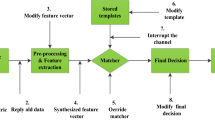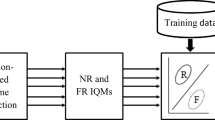Abstract
Biometrics is the state of the art in dealing with identity identification and verification based on the physical and behavioral characteristics and widely used in the fields of Fintech, such as mobile payment and online banking due to its security and convenience. However, there are various attacks against the biometrics system. The presentation attack is one of the most common attacks that an imposter presents fake biometrics to the sensor trying to fool the system. This paper proposes a multimodal presentation attack detection (PAD) method against photo-attack and video-attack in face recognition system by using score level fusion and challenge-response scenario. The proposed challenge-response scenario is that requesting the user to speak out the randomly prompted words. Then, the recognized speech text and the user’s mouth motion are detected simultaneously to verify if the user is liveness. Two weighted score level fusion rules, namely weighted sum and weight product, are used to combine the speech and mouth motion traits as a matching score. The final score is fed into supervised machine learning algorithms and trained for classifying spoofing. The experiments are conducted in the self-built database. Experimental results show that the proposed method can achieve the best half total error rate at 3.64% and can effectively improve facial recognition system security.









Similar content being viewed by others
References
Jain AK, Ross A, Prabhakar S (2004) An introduction to biometric recognition. IEEE Trans Circuits Syst Video Technol 14:4–20
Ross A, Nandakumar K, Jain AK (2006) Handbook of multi-biometrics, 1st edn. Springer, New York
Singh M, Singh R, Ross A (2019) A comprehensive overview of biometric fusion. Inf Fusion 52:187–205
Dinca LM, Hancke GP (2017) The fall of one, the rise of many: a survey on multi-biometric fusion methods. IEEE Access 5:6247–6289
Lumini A, Nanni L (2017) Overview of the combination of biometric matchers. Inf Fusion 33:71–85
Akhtar Z, Rizwan M, Kale S (2011) Multimodal biometric fusion: performance under spoof attacks. J Intell Syst 20(4):353–372
Akhtar Z, Micheloni C, Foresti GL (2015) Biometric liveness detection: challenges and research opportunities. IEEE Secur Priv 13(5):63–72
Dargan S, Kumar M (2020) A comprehensive survey on the biometric recognition systems based on physiological and behavioral modalities. Expert Syst Appl 143:113114
ISO/IEC 30107-1 (2016) Information technology—biometric presentation attack detection—part 1: framework. https://standards.iso.org/ittf/PubliclyAvailableStandards/c053227_ISO_IEC_30107-1_2016.zip
Galbally J, Marcel S, Fierrez J (2014) Biometric antispoofing methods: a survey in face recognition. IEEE Access 2:1530–1552
Souza L, Oliveira L, Pamplona M, Papa J (2018) How far did we get in face spoofing detection? Eng Appl Artif Intell 72:368–381
Ramachandra R, Busch C (2017) Presentation attack detection methods for face recognition systems: a comprehensive survey. ACM Comput Surv 50(1):1–37. https://doi.org/10.1145/3038924
Aleksic PS, Katsaggelos AK (2006) Audio-visual biometrics. Proc IEEE 94(11):2025–2044
Eveno N, Besacier L (2005) A speaker independent “liveness” test for audio-visual biometrics. In: 9th European Conference on Speech Communication and Technology, pp 3081–3084
Bredin H, Chollet G (2007) Audio-visual speech synchrony measure: application to biometrics. EURASIP J Adv Signal Process 2007(1):70186. https://doi.org/10.1155/2007/70186
Argones RE, Bredin H, Garca MC, Chollet G, Gonzlez JD (2009) Audio-visual speech asynchrony detection using co-inertia analysis and coupled hidden markov models. Pattern Anal Appl 12(3):271–284
Melnikov A, Akhunzyanov R, Oleg K, Luckyanets E (2015) Audiovisual liveness detection. In: International Conference on Image Analysis and Processing (ICIAP 2015), vol 9280, pp 643–652
Boutellaa E, Boulkenafet Z, Komulainen J, Hadid A (2016) Audiovisual synchrony assessment for replay attack detection in talking face biometrics. Multimed Tools Appl 75(9):5329–5343
Sanderson C, Paliwal KK (2002) Information fusion and person verification using speech and face information. Research paper IDIAP-RR 02-33, Martigny, Switzerland, pp 1–8
Soukupová T, Ćech J, (2016) Real-time eye blink detection using facial landmarks. In: Proceedings of 21st Computer Vision Winter Workshop
Intelligent Behaviour Understanding Group (iBUG) facial point annotations. https://ibug.doc.ic.ac.uk/resources/facial-point-annotations. Accessed Dec 2019
Gali N, Mariescu-Istodor R, Hostettler D (2019) Framework for syntactic string similarity measures. Expert Syst Appl 129:169–185
Zhang Z, Yan J, Liu S, Lei Z, Yi D, Li SZ (2012) A face antispoofing database with diverse attacks. In: Proceedings of 2012 5th IAPR International Conference on Biometrics (ICB), pp 26–31
Chingovska I, Anjos A, Marcel S (2012) On the effectiveness of local binary patterns in face anti-spoofing. In: Proceedings of 2012 BIOSIG-Proceedings of the International Conference of the Biometrics Special Interest Group (BIOSIG), pp 1–7
Wen D, Han H, Jain A (2015) Face spoof detection with image distortion analysis. IEEE Trans Inf Forensics Secur 10(4):746–761
Author information
Authors and Affiliations
Corresponding author
Additional information
Publisher's Note
Springer Nature remains neutral with regard to jurisdictional claims in published maps and institutional affiliations.
Rights and permissions
About this article
Cite this article
Chou, CL. Presentation attack detection based on score level fusion and challenge-response technique. J Supercomput 77, 4681–4697 (2021). https://doi.org/10.1007/s11227-020-03461-1
Accepted:
Published:
Issue Date:
DOI: https://doi.org/10.1007/s11227-020-03461-1




